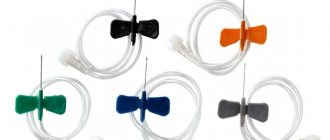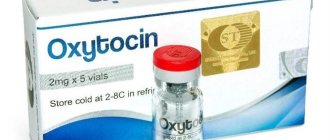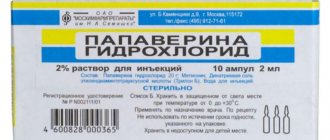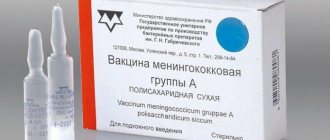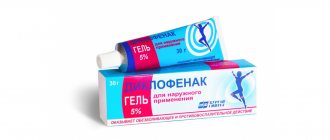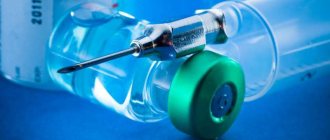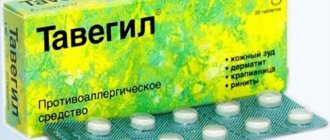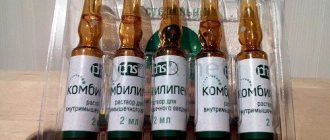In what cases is a drip with aminophylline prescribed?
Parenteral administration of aminophylline is indicated in the following cases:
- Relief of status asthmaticus, reversible bronchospasms of various etiologies, pulmonary emphysema;
- Pulmonary hypertension, as a component of complex therapy for “emphysematous heart”;
- Combinations of cardiac asthma and bronchospasm, respiratory disorders of central origin;
- Relief of cerebral vegetative-vascular crises against the background of atherosclerosis of cerebral vessels;
- In the treatment of cerebral blood flow insufficiency, cerebral edema, osteochondrosis of the cervical spine;
- Intensive therapy of ischemic stroke.
Contraindications to the use of aminophylline:
- Acute cardiovascular failure;
- Angina pectoris, acute coronary syndrome;
- Severe disturbances of rhythm and intracardiac conduction;
- Hemorrhagic stroke, intracerebral hemorrhage;
- Pulmonary edema;
- Peptic ulcer of the stomach and duodenum in the acute stage;
- Epilepsy, convulsive syndrome;
- Hormonal pathology of the thyroid gland;
- Multiple organ failure;
- Pregnancy and breastfeeding.
Side effects
When taking Eufillin, in addition to the main pharmacological action, side effects may also occur. Most often, patients develop insomnia, dizziness, weakness, tachycardia, arrhythmia, dyspeptic syndrome, allergic reactions, hypoglycemia, hypotension, increased sweating, pain in the head, chest and abdomen.
Against the background of a drug overdose, muscle cramps, increased body temperature, polyuria, hematuria, albuminuria and even disturbances of consciousness may occur.
To eliminate adverse symptoms, it may be necessary to reduce the dosage or stop taking the drug.
If the rules of asepsis and antisepsis are violated during injections of Eufillin, infectious complications sometimes develop.
Technique, solution components and frequency of procedure
Eufillin is administered exclusively intravenously under the supervision of medical personnel!
Instructions for using aminophylline for droppers require the following certain rules:
- The solution temperature should be 370C;
- If possible, administer in the first half of the day (the drug has a stimulating effect on the central nervous system);
- Aminophylline should be diluted only in 0.9% sodium chloride solution;
- It is prohibited to mix the drug in one syringe for bolus administration.
Prepare the solution immediately before administration. Storage of residues and reuse is unacceptable.

When injecting aminophylline, the patient should be in a supine position. It is necessary to monitor blood pressure, heart rate, breathing parameters and the general subjective state of the patient. In case of rapid administration, increased heart rate, nausea, and vertigo may occur.
Asthmatic status. In case of a serious condition of the patient, it is permissible to administer aminophylline intravenously as a bolus for 5 minutes under blood pressure control with a transition to intravenous drip administration. Dilute 15 ml of aminophylline solution 2.4% in 200 ml. saline solution, add 90-120 mg of prednisolone and administer at a rate of 30-50 drops per minute. When the patient’s condition normalizes, they are transferred to alternative forms of the drug.
Pulmonary hypertension. Dilute 10-15 ml of 2.4% aminophylline in 150 ml of saline solution. Inject at a rate of 30-40 drops per minute. The saturation dose is 3 mg/kg/day. When systemic pressure decreases, they switch to tablet forms of methylxanthines.
Cerebral vascular crisis. The administration of aminophylline is combined with papaverine 2-4 ml, beta blockers (anaprilin 0.25% diluted in 500 ml. 5% glucose).
Ischemic stroke and cerebral edema. 10 ml of a 2.4% solution of aminophylline in 150 ml of saline in combination with dexamethasone, 2.0-4.0 ml of Lasix, 10 ml are administered intravenously. 25% magnesia. Additionally, L-lysine aescinate is administered 5-10 ml per 100 ml of saline solution slowly by drip. This treatment is carried out until clinical improvement.
Osteochondrosis. During periods of exacerbation, it is advisable to prescribe combined droppers with aminophylline, painkillers (analgin, baralgin), dexamethasone, Lasix, papaverine. The course of treatment lasts no longer than 7-10 days.
If possible, you need to monitor the level of potassium and theophylline in the blood serum, and do not exceed a daily dose of 10 mg/kg.
During treatment with aminophylline, you should refrain from drinking alcohol and products containing methylxanthine (coffee, cocoa, chocolate, tea).
Composition and release form
The composition of the drug depends on the form of release of the drug. Eufillin is produced in the following versions:
- Pills. One piece contains the active substance - aminophylline (150 milligrams), as well as auxiliary components. The latter include calcium, stearic acid and potato starch.
- Ampoules (solution for injection). Aminophylline is also the main substance. Each ampoule contains 24 milligrams of the active ingredient. In addition to it, the composition also contains water for injection.
What effect is expected from taking a dropper?
Effects of parenteral aminophylline:
- Relieves obstruction in patients with bronchial asthma, emphysema;
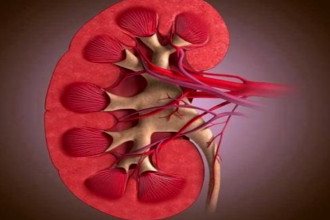
- Optimizes the functions of the respiratory and intercostal muscles;
- Improves respiratory function parameters, blood oxygen saturation, stimulates the respiratory center;
- Balances blood rheological parameters, inhibits platelet aggregation;
- Stimulates the activity of the central nervous system, cardiac contractility, increases coronary blood flow;
- Relieves the tone of the walls of blood vessels;
- Reduces perifocal cerebral edema, intracranial pressure;
- Reduces the general resistance of the arteries of the pulmonary circulation;
- Increases renal perfusion, moderately stimulates diuresis;
- Improves microcirculation in cartilage tissue, relieves inflammatory swelling.
It is worth remembering the likelihood of side effects:
- Vertigo, migraine, psychomotor agitation, sleep disorder, tremor, convulsive syndrome, insomnia, hallucinations;
- Epigastric discomfort, nausea, gastroesophageal reflux, heartburn, exacerbation of stomach ulcers, diarrhea, anorexia;
- Metabolic imbalance, disturbance of the acid-base state of the blood;
- Rhythm disturbances, tachycardia, vascular collapse, exacerbation of angina pectoris, extrasystoles, progression of heart failure;
- Hyperthermia, facial redness, sweating, shortness of breath.
Pharmacological effects
The main effect of the drug is antispasmodic. However, it also has other effects on the human body, namely tocolytic, diuretic and bronchodilator.
According to the Vidal classifier, Eufillin is included in the pharmacological group of phosphodiesterase inhibitors.
What does Eufillin help with? Indications for use
Indications for use of the drug Eufillin may vary slightly depending on the form of release. Tablets are most often prescribed for:
- Bronchial asthma of varying severity.
- Chronic obstructive pulmonary disease.
- Paroxysmal attacks of apnea at night.
- Right ventricular heart failure.
- Emphysema.
The injection form of the drug is used for:
- Cerebrovascular insufficiency of the brain (the drug is used in combination with other drugs and helps reduce intracranial pressure).
- Pulmonary hypertension.
- Left ventricular heart failure (also used in combination with a number of other drugs).
- For diseases of the respiratory system accompanied by spasm and broncho-obstructive syndrome (COPD, emphysema, bronchial asthma).
Mechanism of action and physicochemical properties of aminophylline
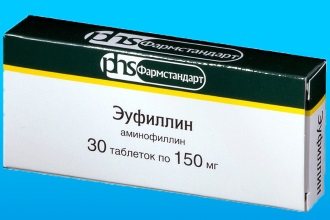
Physicochemical characteristics:
- whitish or yellowish powder;
- weak ammonia odor;
- dissolves in water.
Description of the spectrum of effects and mechanism of action:
- blocks adenosine receptors and inhibits the action of phosphodiesterase, which promotes the accumulation of cyclic adenosine monophosphate;
- reduces the influx of calcium ions to cell membranes, thereby reducing the contraction of smooth muscles;
- the effect is mainly due to theophylline;
- relieves bronchospasm (bronchodilator effect);
- improves blood circulation in the kidneys;
- weak diuretic effect;
- slows down platelet adhesion;
- improves diaphragm performance;
- stimulates the respiratory center, which in turn improves gas exchange and reduces the frequency of apnea;
- normalizes breathing, and this increases blood saturation with oxygen and reduces the level of carbon dioxide in it;
- stimulates the heart, increasing the frequency and strength of contractions, and also improves coronary blood flow;
- relaxes blood vessels;
- relieves spasm from the peripheral and pulmonary veins, which helps reduce pressure in the “lesser” circulation.
- relieves spasm from the bile ducts;
- thins the blood;
- reduces uterine tone;
- increases the acidity of stomach juice.
conclusions
To summarize, I would like to say that, despite such a long existence of aminophylline in pharmacology, the demand for it has not decreased. It is a strong medicine and is often used to relieve emergency conditions, as it gives a very good result. But in addition to injections, it is also used in tablets, electrophoresis is performed with liquid (in neurology for osteochondrosis and various diseases of the spine), and inhalations are made using a nebulizer. When taking it, you should adhere to the doctor’s prescriptions and do not adjust the dose and duration of the course yourself, since this medication has a number of severe side effects for the body, and this can cause many problems.
Reviews about the drug
Reviews of Euphylline, like any other medicinal drug, are very diverse on the Internet. However, most patients note its high effectiveness and rapid elimination of symptoms of the disease.
There are also negative reviews, but they are most often associated with the development of adverse reactions due to individual intolerance to a component of the drug or as a result of an incorrectly selected dosage.
Some patients use Eufillin in combination with Dimexide and a number of essential oils for weight loss and getting rid of cellulite. The effectiveness of the drug in this regard has not been proven, so it is impossible to objectively judge its effectiveness.
Attention! Before taking the medicine, consultation with a specialist is required. Only a doctor will be able to select the correct dosage of the drug, calculate the duration of the course of treatment and take into account all the indications and contraindications for taking Eufillin. Otherwise, there is a high risk of developing negative side effects.
Eufillin price
The price of Eufillin tablets (150 mg No. 30) in Russian pharmacies is 10-12 rubles, a 2.4% solution in 5 ml ampoules (package No. 10) can be bought for 35 rubles, in 10 ml ampoules (package No. 10) - for 40 rubles
In Ukraine, the cost of tablets is from 13 UAH, the price of Eufillin ampoules is from 21 UAH.
- Online pharmacies in RussiaRussia
- Online pharmacies in UkraineUkraine
- Online pharmacies in KazakhstanKazakhstan
ZdravCity
- Eufillin solution intravenously.
24mg/ml amp. 5ml No. 10 JSC Dalkhimfarm 48 rub. order - Eufillin solution for intravenous injection. 24 mg/ml 10 ml 10 pcs. JSC Novosibirsk Chemical Plant
110 rub. order
Pharmacy Dialogue
- Eufillin (amp. 2.4% 5ml No. 10)Grotex LLC
58 RUR order
- Eufillin (tab. 150 mg No. 30 (bl.)) FS.-Leksredstva
13 rub. order
- Eufillin (tab. 150 mg No. 30 (bl.)) Usolye-Sibirsky Chemical Physics Complex
33 rub. order
- Eufillin (amp. 2.4% 5ml No. 10) DHF JSC
50 rub. order
- Eufillin (amp. 2.4% 10ml No. 10)Novosibkhimpharm OJSC
101 rub. order
show more
Pharmacy24
- Eufillin-pharm 0.4 g No. 30 capsules TOV VTF "Farmakom", Ukraine
23 UAH. order - Eufillin-N 200 2% 5 ml No. 10 solution PAT "Farmak", Ukraine
22 UAH order
- Eufillin-Darnitsa 2% 5 ml No. 10 solution
30 UAH order
- Eufillin-pharm 0.25 g No. 40 tablets TOV VTF "Farmakom", Ukraine
17 UAH order
- Eufillin-pharm 0.25 g No. 80 tablets TOV VTF "Farmakom", Ukraine
31 UAH order
PaniPharmacy
- Eufillin ampoule Eufillin 200 solution d/in. 2% amp. 5ml No. 10 Ukraine, Darnitsa ChAO
33 UAH order
- Eufillin ampoule Eufillin solution d/in. 2% amp. 5ml No. 10 Ukraine, Health LLC
30 UAH order
- Eufillin-pharm tablets 0.25g N40 Ukraine, Farmakom PTF LLC
17 UAH order
- Eufillin-pharm tablets 0.25g N80 Ukraine, Farmakom PTF LLC
30 UAH order
- Eufillin-pharm capsules 0.4g No. 30 Ukraine, Farmakom PTF LLC
24 UAH order
show more
Symptoms of overdose and its consequences
An overdose occurs when the saturation of aminophylline in the blood is above 20 mg/kg. More common in older people. Coma – at 40 mg/kg.
The following symptoms are observed:
- Redness of the facial skin.
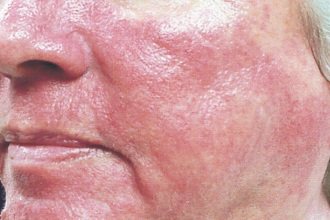
Tachycardia.- Insomnia.
- Motor excitement.
- Anxiety.
- Photophobia.
- Complete lack of appetite.
- Diarrhea.
- Nausea.
- Vomit.
- Pain in the upper abdomen.
- Shiver.
- Rapid breathing.
- Cramps.
- A sharp decrease in pressure.
Consequences:
- Gastrointestinal bleeding.
- Ventricular arrhythmias.
- Decreased oxygen in the blood.
- Metabolic acidosis.
- Increased blood sugar.
- Decreased potassium in the blood.
- Destruction of skeletal muscles.
- Eclipse of consciousness.
- Kidney failure.
Treatment for overdose
The algorithm for providing assistance in case of overdose depends on the severity of the symptoms and includes:

Discontinuation of the drug.- Gastric lavage.
- Reception of sorbents.
- Normalization of pressure.
- Forced diuresis.
- Hemosorption and plasmasorption (method of purifying blood from poisons).
- Hemo- and peritoneal dialysis.
- Oxygen.
- Artificial ventilation.
- Symptomatic therapy (motilium, cerucal).
- In the event of a seizure attack, the airways must be kept patent; give oxygen; administer diazepam intravenously at a dose of 0.1-0.3 mg/kg (not more than 10 mg).
To avoid adverse reactions, the saturation of the drug in the blood should be kept no higher than 10-15 mg/kg.
Solution for intravenous administration Euphyllin
Instructions for medical use of the drug
Description of pharmacological action
Bronchodilator, PDE inhibitor. It is the ethylenediamine salt of theophylline (which facilitates solubility and increases absorption). It has a bronchodilator effect, apparently due to a direct relaxing effect on the smooth muscles of the respiratory tract and blood vessels of the lungs. It is believed that this effect is caused by selective inhibition of the activity of specific PDEs, which leads to an increase in the intracellular concentration of cAMP. The results of in vitro experimental studies show that the main role appears to be played by type III and IV isoenzymes. Suppression of the activity of these isoenzymes may also cause some side effects of aminophylline (theophylline), including. vomiting, arterial hypotension and tachycardia. Blocks adenosine (purine) receptors, which may be one of the factors affecting the bronchi. Reduces airway hyperresponsiveness associated with the late phase response caused by inhaled allergens through an unknown mechanism that is not due to PDE inhibition or blockade of adenosine. There are reports that aminophylline increases the number and activity of T-suppressor cells in peripheral blood. Increases mucociliary clearance, stimulates contraction of the diaphragm, improves the function of the respiratory and intercostal muscles, stimulates the respiratory center, increases its sensitivity to carbon dioxide and improves alveolar ventilation, which ultimately leads to a decrease in the severity and frequency of apnea episodes. By normalizing respiratory function, it helps saturate the blood with oxygen and reduce the concentration of carbon dioxide. Strengthens ventilation of the lungs in conditions of hypokalemia. It has a stimulating effect on the activity of the heart, increases strength and heart rate, increases coronary blood flow and increases the myocardial oxygen demand. Reduces the tone of blood vessels (mainly those of the brain, skin and kidneys). It has a peripheral venodilating effect, reduces pulmonary vascular resistance, and lowers pressure in the pulmonary circulation. Increases renal blood flow and has a moderate diuretic effect. Expands extrahepatic bile ducts. Stabilizes mast cell membranes, inhibits the release of mediators of allergic reactions. Inhibits platelet aggregation (suppresses platelet activating factor and PgE2α), increases the resistance of red blood cells to deformation (improves the rheological properties of blood), reduces thrombus formation and normalizes microcirculation. It has a tocolytic effect, increases the acidity of gastric juice. In high doses it has an epileptogenic effect.
Indications for use
For parenteral use: status asthmaticus (additional therapy), neonatal apnea, ischemic cerebrovascular accident (as part of combination therapy), left ventricular failure with bronchospasm and Cheyne-Stokes type breathing disorder, edematous syndrome of renal origin (as part of complex therapy) ; acute and chronic heart failure (as part of combination therapy). For oral administration: broncho-obstructive syndrome of various origins (including bronchial asthma, COPD, including emphysema, chronic obstructive bronchitis), hypertension in the pulmonary circulation, cor pulmonale, sleep apnea; acute and chronic heart failure (as part of combination therapy).
Release form
solution for intravenous administration 24 mg/ml; ampoule 5 ml with ampoule knife, cardboard pack 10; solution for intravenous administration 24 mg/ml; ampoule 10 ml with ampoule knife, cardboard pack 10; solution for intravenous administration; ampoule 10 ml, box (box) 5; EAN code: 4602672000041; solution for intravenous administration 24 mg/ml; 10 ml ampoule with ampoule knife, contour plastic packaging (pallets) 10, cardboard pack 1; solution for intravenous administration 24 mg/ml; ampoule 10 ml with ampoule knife, cardboard pack 10; solution for intravenous administration 24 mg/ml; ampoule 10 ml with ampoule knife, cardboard box (box) 10; solution for intravenous administration 24 mg/ml; 5 ml ampoule with ampoule knife, contour plastic packaging (pallets) 10, cardboard pack 1; solution for intravenous administration 24 mg/ml; ampoule 5 ml with ampoule knife, cardboard box (box) 10; solution for intravenous administration 24 mg/ml; ampoule 10 ml with ampoule knife, cardboard pack 10; solution for intravenous administration 24 mg/ml; ampoule 5 ml with ampoule knife, cardboard pack 10; solution for intravenous administration 24 mg/ml; ampoule 10 ml with ampoule knife, cardboard pack 10; solution for intravenous administration 24 mg/ml; 5 ml ampoule with ampoule knife, contour cell packaging 5, cardboard pack 2; solution for intravenous administration 24 mg/ml; ampoule 10 ml with ampoule knife, cardboard pack 10; solution for intravenous administration 24 mg/ml; ampoule 5 ml with ampoule knife, cardboard pack 10; solution for intravenous administration 24 mg/ml; ampoule 10 ml with ampoule knife, cardboard pack 10; solution for intravenous administration 24 mg/ml; ampoule 5 ml with ampoule knife, cardboard pack 10; solution for intravenous administration 24 mg/ml; 5 ml ampoule with ampoule knife, contour cell packaging 5, cardboard pack 1; solution for intravenous administration 24 mg/ml; 5 ml ampoule with ampoule knife, contour cell packaging 5, cardboard pack 2; solution for intravenous administration 24 mg/ml; 5 ml ampoule with ampoule knife, contour packing 10, cardboard pack 1; solution for intravenous administration 24 mg/ml; 5 ml ampoule with ampoule knife, contour pack 10, cardboard pack 2; solution for intravenous administration 24 mg/ml; 10 ml ampoule with ampoule knife, contour cell packaging 5, cardboard pack 1; solution for intravenous administration 24 mg/ml; ampoule 10 ml with ampoule knife, contour pack 5, cardboard pack 2; solution for intravenous administration 24 mg/ml; ampoule 10 ml with ampoule knife, contour packaging 10, cardboard pack 1; solution for intravenous administration 24 mg/ml; ampoule 10 ml with ampoule knife, contour packaging 10, cardboard pack 2; solution for intravenous administration 24 mg/ml; 10 ml ampoule with ampoule knife, contour cell packaging 5, cardboard pack 1; solution for intravenous administration 24 mg/ml; ampoule 10 ml with ampoule knife, contour pack 5, cardboard pack 2; solution for intravenous administration 24 mg/ml; 5 ml ampoule with ampoule knife, contour cell packaging 5, cardboard pack 1; solution for intravenous administration 24 mg/ml; 5 ml ampoule with ampoule knife, contour cell packaging 5, cardboard pack 2; solution for intravenous administration 24 mg/ml; ampoule 5 ml, contour plastic packaging (pallets) 10, cardboard pack 1; solution for intravenous administration 24 mg/ml; ampoule 5 ml, contour plastic packaging (pallets) 10, cardboard box (box) 10; solution for intravenous administration 24 mg/ml; ampoule 5 ml, contour plastic packaging (pallets) 10, cardboard box (box) 20; solution for intravenous administration 24 mg/ml; ampoule 5 ml, contour plastic packaging (pallets) 10, cardboard box (box) 30; solution for intravenous administration 24 mg/ml; ampoule 10 ml, contour plastic packaging (pallets) 10, cardboard pack 1; solution for intravenous administration 24 mg/ml; ampoule 10 ml, contour plastic packaging (pallets) 10, cardboard box (box) 10; solution for intravenous administration 24 mg/ml; ampoule 10 ml, contour plastic packaging (pallets) 10, cardboard box (box) 20; solution for intravenous administration 24 mg/ml; ampoule 10 ml, contour plastic packaging (pallets) 10, cardboard box (box) 30; solution for intravenous administration 24 mg/ml; ampoule 5 ml, contour pack 10, cardboard pack 1; solution for intravenous administration 24 mg/ml; ampoule 10 ml, contour pack 10, cardboard pack 1; solution for intravenous administration 24 mg/ml; ampoule 5 ml, contour pack 10, cardboard pack 1; solution for intravenous administration 24 mg/ml; ampoule 5 ml, contour cell packaging 10, cardboard box (box) 10; solution for intravenous administration 24 mg/ml; ampoule 5 ml, contour cell packaging 10, cardboard box (box) 20; solution for intravenous administration 24 mg/ml; ampoule 5 ml, contour cell packaging 10, cardboard box (box) 30; solution for intravenous administration 24 mg/ml; ampoule 10 ml, contour pack 10, cardboard pack 1; solution for intravenous administration 24 mg/ml; ampoule 10 ml, contour cell packaging 10, cardboard box (box) 10; solution for intravenous administration 24 mg/ml; ampoule 10 ml, contour cell packaging 10, cardboard box (box) 20; solution for intravenous administration 24 mg/ml; ampoule 10 ml, contour cell packaging 10, cardboard box (box) 30; solution for intravenous administration 24 mg/ml; ampoule 10 ml with ampoule knife, contour plastic packaging (pallets) 10, cardboard pack 2; solution for intravenous administration 24 mg/ml; 10 ml ampoule with ampoule knife, contour plastic packaging (pallets) 5, cardboard pack 1; solution for intravenous administration 24 mg/ml; 10 ml ampoule with ampoule knife, contour plastic packaging (pallets) 5, cardboard pack 2; solution for intravenous administration 24 mg/ml; 5 ml ampoule with ampoule knife, contour plastic packaging (pallets) 10, cardboard pack 2; solution for intravenous administration 24 mg/ml; 5 ml ampoule with ampoule knife, contour plastic packaging (pallets) 5, cardboard pack 1; solution for intravenous administration 24 mg/ml; 5 ml ampoule with ampoule knife, contour plastic packaging (pallets) 5, cardboard pack 2; solution for intravenous administration 24 mg/ml; ampoule 10 ml with ampoule knife, cardboard box (box) 10; solution for intravenous administration 24 mg/ml; ampoule 5 ml with ampoule knife, cardboard box (box) 10; solution for intravenous administration 24 mg/ml; ampoule 5 ml with ampoule knife, cardboard pack 10; solution for intravenous administration 24 mg/ml; 10 ml ampoule with ampoule knife, contour cell packaging 5, cardboard pack 1; solution for intravenous administration 24 mg/ml; ampoule 10 ml with ampoule knife, contour pack 5, cardboard pack 2; solution for intravenous administration 24 mg/ml; 5 ml ampoule with ampoule knife, contour cell packaging 5, cardboard pack 1; solution for intravenous administration 24 mg/ml; 5 ml ampoule with ampoule knife, contour cell packaging 5, cardboard pack 2; solution for intravenous administration 24 mg/ml; ampoule 5 ml with ampoule knife, cardboard pack 10; solution for intravenous administration 24 mg/ml; ampoule 10 ml with ampoule knife, cardboard pack 10; solution for intravenous administration 24 mg/ml; 5 ml ampoule with ampoule knife, contour cell packaging 5, cardboard pack 1; No. P N013516/01, 2009-05-18 from Borisov Medical Preparations Plant (Republic of Belarus) Eufillin solution for intravenous administration 24 mg/ml; 5 ml ampoule with ampoule knife, contour cell packaging 5, cardboard pack 2; solution for intravenous administration 24 mg/ml; 10 ml ampoule with ampoule knife, contour cell packaging 5, cardboard pack 1; solution for intravenous administration 24 mg/ml; ampoule 10 ml with ampoule knife, contour pack 5, cardboard pack 2; solution for intravenous administration 24 mg/ml; 5 ml ampoule with ampoule knife, cardboard pack, covered with a parcel post 10; solution for intravenous administration 24 mg/ml; ampoule 5 ml with ampoule knife, cardboard box (box) 10; solution for intravenous administration 24 mg/ml; ampoule 10 ml with ampoule knife, cardboard box (box) 10; solution for intravenous administration 24 mg/ml; 10 ml ampoule with ampoule knife, contour cell packaging 5, cardboard pack 1; solution for intravenous administration 24 mg/ml; ampoule 10 ml with ampoule knife, contour pack 5, cardboard pack 2; solution for intravenous administration 24 mg/ml; ampoule 10 ml with ampoule knife, contour packaging 10, cardboard pack 1; solution for intravenous administration 24 mg/ml; ampoule 10 ml with ampoule knife, contour packaging 10, cardboard pack 2; solution for intravenous administration 24 mg/ml; 5 ml ampoule with ampoule knife, contour cell packaging 5, cardboard pack 1; solution for intravenous administration 24 mg/ml; 5 ml ampoule with ampoule knife, contour cell packaging 5, cardboard pack 2; solution for intravenous administration 24 mg/ml; 5 ml ampoule with ampoule knife, contour packing 10, cardboard pack 1; solution for intravenous administration 24 mg/ml; 5 ml ampoule with ampoule knife, contour pack 10, cardboard pack 2; solution for intravenous administration 24 mg/ml; 5 ml ampoule with ampoule knife, contour packaging 5, cardboard pack 1; solution for intravenous administration 24 mg/ml; ampoule 10 ml with ampoule knife, contour packaging 10, cardboard pack 2; solution for intravenous administration 24 mg/ml; 10 ml ampoule with ampoule knife, contour packaging 5, cardboard pack 1; solution for intravenous administration 24 mg/ml; 10 ml ampoule with ampoule knife, contour packaging 5, cardboard pack 2; solution for intravenous administration 24 mg/ml; 5 ml ampoule with ampoule knife, contour packaging 5, cardboard pack 2; solution for intravenous administration 24 mg/ml; 5 ml ampoule with ampoule knife, contour packaging 10, cardboard pack 1; solution for intravenous administration 24 mg/ml; 5 ml ampoule with ampoule knife, contour packaging 10, cardboard pack 2; solution for intravenous administration 24 mg/ml; 5 ml ampoule with ampoule knife, contour plastic packaging (pallets) 5, cardboard pack 1; solution for intravenous administration 24 mg/ml; 5 ml ampoule with ampoule knife, contour plastic packaging (pallets) 5, cardboard pack 2; solution for intravenous administration 24 mg/ml; 10 ml ampoule with ampoule knife, contour plastic packaging (pallets) 5, cardboard pack 1; solution for intravenous administration 24 mg/ml; 10 ml ampoule with ampoule knife, contour plastic packaging (pallets) 5, cardboard pack 2; solution for intravenous administration 24 mg/ml; ampoule 10 ml with ampoule knife, contour packaging 10, cardboard pack 2; solution for intravenous administration 24 mg/ml; ampoule 5 ml with ampoule knife, cardboard pack 10; solution for intravenous administration 24 mg/ml; 5 ml ampoule with ampoule knife, cardboard pack with cardboard insert for fixing ampoules 10; solution for intravenous administration 24 mg/ml; ampoule 10 ml with ampoule knife, cardboard pack with cardboard insert for fixing ampoules 10; solution for intravenous administration 24 mg/ml; ampoule 10 ml with ampoule knife, contour pack 5, cardboard pack 2; solution for intravenous administration 24 mg/ml; ampoule 10 ml with ampoule knife, cardboard pack 10; solution for intravenous administration 24 mg/ml; ampoule 5 ml with ampoule knife, cardboard pack 10; solution for intravenous administration 24 mg/ml; ampoule 5 ml with ampoule knife, cardboard box (box) 10; solution for intravenous administration 24 mg/ml; ampoule 5 ml, contour plastic packaging (pallets) 10, cardboard pack 1; solution for intravenous administration 24 mg/ml; ampoule 5 ml, contour plastic packaging (pallets) 10, cardboard box (box) 10; solution for intravenous administration 24 mg/ml; ampoule 5 ml, contour plastic packaging (pallets) 10, cardboard box (box) 20; solution for intravenous administration 24 mg/ml; ampoule 5 ml, contour plastic packaging (pallets) 10, cardboard box (box) 30; solution for intravenous administration 24 mg/ml; ampoule 10 ml, contour plastic packaging (pallets) 10, cardboard pack 1; solution for intravenous administration 24 mg/ml; ampoule 10 ml, contour plastic packaging (pallets) 10, cardboard box (box) 10; solution for intravenous administration 24 mg/ml; ampoule 10 ml, contour plastic packaging (pallets) 10, cardboard box (box) 20; solution for intravenous administration 24 mg/ml; ampoule 10 ml, contour plastic packaging (pallets) 10, cardboard box (box) 30; Composition: 1 ampoule with 5 or 10 ml of solution for injection contains 0.12 or 0.24 g of aminophylline; in a cardboard box 10 pcs.
Pharmacodynamics
Bronchodilator, PDE inhibitor. It is the ethylenediamine salt of theophylline (which facilitates solubility and increases absorption). It has a bronchodilator effect, apparently due to a direct relaxing effect on the smooth muscles of the respiratory tract and blood vessels of the lungs. It is believed that this effect is caused by selective inhibition of the activity of specific PDEs, which leads to an increase in the intracellular concentration of cAMP. The results of in vitro experimental studies show that the main role appears to be played by type III and IV isoenzymes. Suppression of the activity of these isoenzymes may also cause some side effects of aminophylline (theophylline), including. vomiting, arterial hypotension and tachycardia. Blocks adenosine (purine) receptors, which may be one of the factors affecting the bronchi. Reduces airway hyperresponsiveness associated with the late phase response caused by inhaled allergens through an unknown mechanism that is not due to PDE inhibition or blockade of adenosine. There are reports that aminophylline increases the number and activity of T-suppressor cells in peripheral blood. Increases mucociliary clearance, stimulates contraction of the diaphragm, improves the function of the respiratory and intercostal muscles, stimulates the respiratory center, increases its sensitivity to carbon dioxide and improves alveolar ventilation, which ultimately leads to a decrease in the severity and frequency of apnea episodes. By normalizing respiratory function, it helps saturate the blood with oxygen and reduce the concentration of carbon dioxide. Strengthens ventilation of the lungs in conditions of hypokalemia. It has a stimulating effect on the activity of the heart, increases strength and heart rate, increases coronary blood flow and increases the myocardial oxygen demand. Reduces the tone of blood vessels (mainly those of the brain, skin and kidneys). It has a peripheral venodilating effect, reduces pulmonary vascular resistance, and lowers pressure in the pulmonary circulation. Increases renal blood flow and has a moderate diuretic effect. Expands extrahepatic bile ducts. Stabilizes mast cell membranes, inhibits the release of mediators of allergic reactions. Inhibits platelet aggregation (suppresses platelet activating factor and PgE2α), increases the resistance of red blood cells to deformation (improves the rheological properties of blood), reduces thrombus formation and normalizes microcirculation. It has a tocolytic effect, increases the acidity of gastric juice. In high doses it has an epileptogenic effect.
Pharmacokinetics
In the body, aminophylline is metabolized at physiological pH values to release free theophylline. Bronchodilating properties appear at plasma theophylline concentrations of 10-20 mcg/ml. Concentrations above 20 mg/ml are toxic. The stimulating effect on the respiratory center is realized at a lower concentration - 5-10 mcg/ml. Theophylline binding to plasma proteins is approximately 40%; in newborns, as well as in adults with diseases, binding decreases. Plasma protein binding in adults is about 60%, in newborns - 36%, in patients with liver cirrhosis - 36%. Penetrates the placental barrier (the concentration in the fetal blood serum is slightly higher than in the maternal serum). Excreted in breast milk. Theophylline is metabolized in the liver with the participation of several cytochrome P450 isoenzymes, the most important of which is CYP1A2. During metabolism, 1,3-dimethyluric acid, 1-methyluric acid and 3-methylxanthine are formed. These metabolites are excreted in the urine. 10% is excreted unchanged in adults. In newborns, a significant part is excreted in the form of caffeine (due to the immaturity of the pathways for its further metabolism), unchanged - 50%. Significant individual differences in the rate of hepatic metabolism of theophylline are the cause of pronounced variability in clearance values, plasma concentrations, and half-life. Hepatic metabolism is influenced by factors such as age, addiction to tobacco smoking, diet, diseases, and concurrent drug therapy. T1/2 of theophylline in non-smoking patients with bronchial asthma practically without pathological changes in other organs and systems is 6-12 hours, in smokers - 4-5 hours, in children - 1-5 hours, in newborns and premature babies - 10- 45 hours T1/2 of theophylline increases in the elderly and in patients with heart failure or liver disease. Clearance decreases with heart failure, liver dysfunction, chronic alcoholism, pulmonary edema, chronic obstructive pulmonary disease. Ethylenediamine does not affect the pharmacokinetics of theophylline.
Use during pregnancy
Theophylline penetrates the placental barrier. The use of aminophylline during pregnancy may result in potentially dangerous concentrations of theophylline and caffeine in the blood plasma of the newborn. Newborns whose mothers received aminophylline during pregnancy (especially in the third trimester) require medical supervision to monitor possible symptoms of theophylline intoxication. Theophylline is excreted in breast milk. When using aminophylline in a nursing mother during lactation, irritability may occur in the child. Thus, the use of aminophylline during pregnancy and lactation (breastfeeding) is possible in cases where the expected benefit of therapy for the mother outweighs the potential risk for the fetus or child.
Contraindications for use
Severe arterial hyper- or hypotension, tachyarrhythmias, peptic ulcer of the stomach and duodenum in the acute phase, hyperacid gastritis, severe dysfunction of the liver and/or kidneys, epilepsy, hemorrhagic stroke, hemorrhage in the retina, simultaneous use with ephedrine in children, childhood (up to 3 years, for prolonged oral forms - up to 12 years), hypersensitivity to aminophylline and theophylline.
Side effects
From the side of the central nervous system: dizziness, sleep disturbances, anxiety, tremor, convulsions. From the cardiovascular system: palpitations, heart rhythm disturbances; with rapid intravenous administration - the appearance of pain in the heart, decreased blood pressure, tachycardia (including in the fetus when taken in the third trimester of pregnancy), arrhythmias, decreased blood pressure, cardialgia, increased frequency of angina attacks. From the digestive system: nausea, vomiting, gastroesophageal reflux, heartburn, exacerbation of peptic ulcer, diarrhea; with prolonged ingestion - anorexia. From the urinary system: albuminuria, hematuria. Allergic reactions: skin rash, itching, fever. Metabolic disorders: rarely - hypoglycemia. Local reactions: compaction, hyperemia, pain at the injection site; when used rectally, irritation of the rectal mucosa, proctitis. Other: chest pain, tachypnea, flushing, albuminuria, hematuria, hypoglycemia, increased diuresis, increased sweating.
Directions for use and doses
IV slowly (previously diluted in 10–20 ml of isotonic sodium chloride solution), i.m. 0.12–0.24 g 3 times a day for 2 weeks; children IV - 2-3 mg/kg.
Interactions with other drugs
When used simultaneously with sympathomimetics, a mutual enhancement of action occurs; with beta-blockers and lithium preparations - the effect is mutually reduced. The intensity of action of aminophylline may decrease (due to an increase in its clearance) when used simultaneously with phenobarbital, rifampicin, isoniazid, carbamazepine, sulfinpyrazone, phenytoin, as well as in smokers. The intensity of action of aminophylline may increase (due to a decrease in its clearance) when used simultaneously with macrolide antibiotics, lincomycin, quinolones, allopurinol, beta-blockers, cimetidine, disulfiram, fluvoxamine, hormonal contraceptives for oral administration, isoprenaline, viloxazine and when vaccinated against flu Xanthine derivatives may potentiate hypokalemia caused by the action of β2-adrenergic receptor stimulants, corticosteroids and diuretics. Antidiarrheal drugs and enterosorbents reduce the absorption of aminophylline. Pharmaceutically incompatible with acid solutions.
Precautions for use
IV administration should be carried out under careful monitoring of blood circulation, respiration and the general condition of the patient (heart rate, blood pressure, number of respirations).
Special instructions for use
Use with caution in severe coronary insufficiency (acute phase of myocardial infarction, angina pectoris), widespread atherosclerosis, hypertrophic obstructive cardiomyopathy, frequent ventricular extrasystoles, increased convulsive readiness, liver and/or renal failure, gastric and duodenal ulcers (history), with recent bleeding from the gastrointestinal tract, uncontrolled hypothyroidism (possibility of cumulation) or thyrotoxicosis, with prolonged hyperthermia, gastroesophageal reflux, prostatic hypertrophy, in elderly patients, in children (especially orally). Correction of the aminophylline dosage regimen may be required for heart failure, liver dysfunction, chronic alcoholism, fever, and acute respiratory infections. In elderly patients, a dose reduction may be required. When replacing the used dosage form of aminophylline with another, clinical observation and monitoring of the concentration of theophylline in the blood plasma is necessary. Aminophylline is not used simultaneously with other xanthine derivatives. During the treatment period, you should avoid eating foods containing xanthine derivatives (strong coffee, tea). Use with caution simultaneously with anticoagulants, with other theophylline or purine derivatives. Concomitant use with beta-blockers should be avoided. Aminophylline should not be used simultaneously with glucose solution. Do not use rectally in children.
Storage conditions
List B.: In a place protected from light, in a well-closed container.
Best before date
36 months
Interaction with other drugs
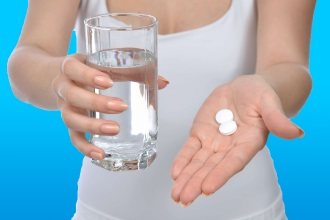
Increases the risk of undesirable effects of hormonal drugs (dexamethasone, cortisol), mineralocorticoids (sodium levels increase).- There is a potential for life-threatening ventricular arrhythmias when combined with medications for general anesthesia.
- Able to prolong the effect of beta blockers and diuretics.
- Increases the toxic effect of drugs that excite the nervous system.
- When taking rifampicin, phenobarbital, phenytoin, isoniazid, carbamazepine, sulfinpyrazone, jazz, it is worth increasing the dose of aminophylline, since the above drugs contribute to its elimination.
- When combined with macrolides, lincomycin, allopurinol, fluoroquinolones, methotrexate, propafenone, verapamil, the effect of the medication is enhanced, so you should be careful and reduce the dose.
- Do not use with xanthines.
